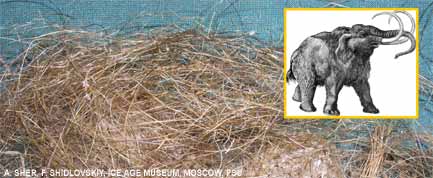
Hair is a better source of ancient DNA than bone or muscle, a new study involving woolly mammoth hair suggests.
"The main problem with things like bone is that it contains real DNA from the source, but also a load of DNA that is undesirable," said study team member Tom Gilbert of the University of Copenhagen. "For example, when a mammoth dies and the body starts putrefying, bacteria gets all throughout the body. Later, as it's buried in the ground, soil bacteria get into it."
Contamination from bacteria DNA generally make up 50 to more than 90 percent of the raw DNA extracted from the bone and muscles of ancient specimens, Gilbert said. In contrast, more than 90 percent of the DNA extracted from hairs taken from woolly mammoth specimens in the new study belonged to the extinct mega-mammals themselves.
"The quality of the DNA was fantastic," Gilbert told LiveScience. "It was way better than we ever imagined. There's both mitochondrial and nuclear DNA in there."
The finding, detailed in the Sept. 28 issue of the journal Science, could simplify DNA extraction in taxonomy, forensics, anthropology, paleontology and other fields. It could also help overcome one of the major hurdles involved in potential attempts to clone extinct animals.
Years to weeks
The researchers obtained hair from 10 woolly mammoth fossils discovered in northern Siberia and that ranged in age from 50,000 to 12,000 years old. One of the samples came from the famous Adams mammoth discovered in 1799 and stored in a Russian museum for 200 years at room temperature—far from ideal conditions for DNA preservation.
Get the world’s most fascinating discoveries delivered straight to your inbox.
Before this study, only seven mitochondrial genomes from extinct animals had been published: four from ancient birds, two from mammoths and one from a mastodon. Mitochondria are the energy power houses of cells and carry their own separate DNA for reproduction.
"They all represented a lot of work, years of work," Gilbert said. "Our method showed that in less than a week, you can get 10 of them."
The amount of mammoth hair used in the study ranged from 0.2 to 5 grams, but the team believes that even smaller samples could be used. "It's not inconceivable that in the very near future, you can get away with just a couple of hair shafts or even just one hair shaft," Gilbert said.
Key ingredient
The secret to hair's protective powers lies in keratin, the protein that hair is made of. "We realized that the keratin in hair could protect the DNA it contains from outside influences, and hence from the sorts of degradation that affect DNA in other parts of the body, such as bone," Gilbert said.
Hair is also easier to rid of bacterial DNA. Washing hair in a solution that kills and washes off external DNA still preserves the genetic material within, the researchers found.
While it might seem counterintuitive that hair provides more protection for DNA than bone, "that's because a lot of people don't realize quite what bone is," Gilbert said. "Bone is really, really spongy. It's really full of air."
Fresh bone is about 8 percent air, while old bones might contain up to 50 percent air, Gilbert said. "What that means is that if you dump [bone] in soil and there's a lot of water around, the water will rush right in and carry bacteria into it," he said. "Hair, on the other hand, has this hydrophobic keratin. Water stays out of it."
The new study overturns previous assumptions about where in hair DNA could be harvested. "When people thought of sequencing DNA from hair, the usual assumption was that the material must come from the hair root, which contains recognizable cells, because the hair shaft appears to be dead," said study team member Webb Miller of Pennsylvania State University.
But the researchers found that a hair shaft encases DNA in a kind of "biologic plastic." Protected, the DNA can better resist damage from the elements and contamination from bacteria.
Keratin is also the primary component of nails and horns, so it's possible pristine DNA could be extracted from these other body parts as well, Gilbert said.
Implications for cloning
The team suspects their method will work best for hair samples preserved in museums or in very cold climates.
"Permafrost is great. Mummies from the Andes, Greenland or places in North Canada—they'll be great," Gilbert said. "Egypt, we're not so hopeful. There is hair on some Egyptian mummies, but it's very hot in Egypt. The way DNA breaks down is very heat dependent. Hair might survive the heat, but DNA won't always."
Hair might also be the key to future attempts at cloning extinct animals, Gilbert said. "It provides the basic ingredient upon which you can start," he said. "To do cloning, what you've got to do is first recover the genome, and secondly, you have to somehow get life to start using the genome. That's the tricky bit. Our method makes the first part a lot more trivial than it used to be. It's just a matter of time and money now."
- Genes: The Instruction Manuals for Life
- Image Gallery: The World's Biggest Beasts
- The Top 10 Worst Heredity Conditions
 Live Science Plus
Live Science Plus





